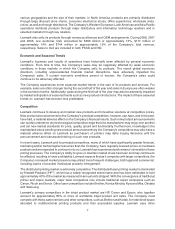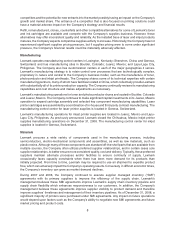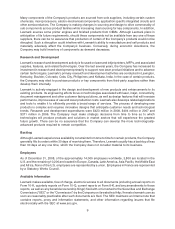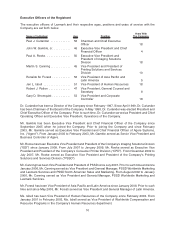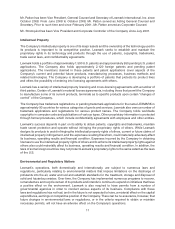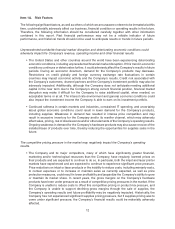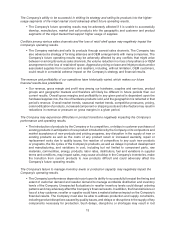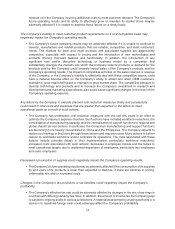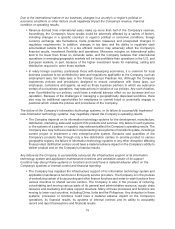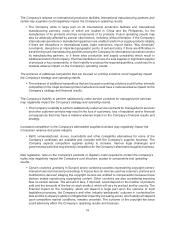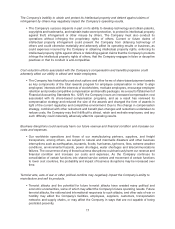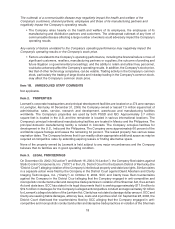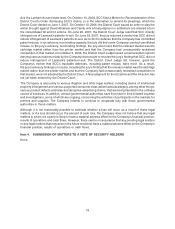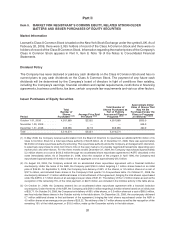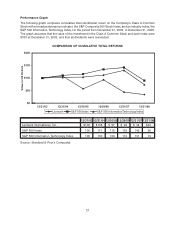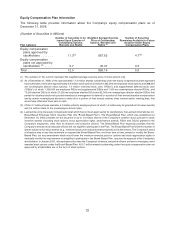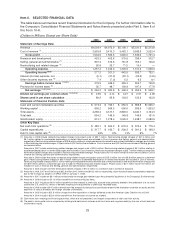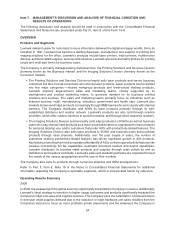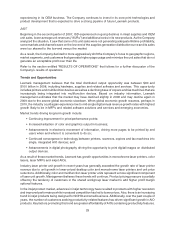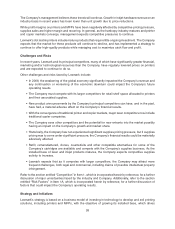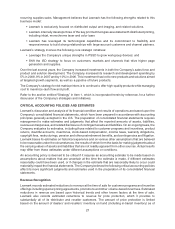Lexmark 2008 Annual Report Download - page 23
Download and view the complete annual report
Please find page 23 of the 2008 Lexmark annual report below. You can navigate through the pages in the report by either clicking on the pages listed below, or by using the keyword search tool below to find specific information within the annual report.The Company’s inability to obtain and protect its intellectual property and defend against claims of
infringement by others may negatively impact the Company’s operating results.
• The Company’s success depends in part on its ability to develop technology and obtain patents,
copyrights and trademarks, and maintain trade secret protection, to protect its intellectual property
against theft, infringement or other misuse by others. The Company must also conduct its
operations without infringing the proprietary rights of others. Current or future claims of
intellectual property infringement could prevent the Company from obtaining technology of
others and could otherwise materially and adversely affect its operating results or business, as
could expenses incurred by the Company in obtaining intellectual property rights, enforcing its
intellectual property rights against others or defending against claims that the Company’s products
infringe the intellectual property rights of others, that the Company engages in false or deceptive
practices or that its conduct is anti-competitive.
Cost reduction efforts associated with the Company’s compensation and benefits programs could
adversely affect our ability to attract and retain employees.
• The Company has historically used stock options and other forms of share-based payment awards
as key components of the total rewards program for employee compensation in order to align
employees’ interests with the interests of stockholders, motivate employees, encourage employee
retention and provide competitive compensation and benefits packages. As a result of Statement of
Financial Accounting Standards No. 123R, the Company incurs an increased compensation cost
associated with its share-based compensation programs, and as a result has reviewed its
compensation strategy and reduced the size of the awards and changed the form of awards in
light of the current regulatory and competitive environment. Due to this change in compensation
strategy, combined with other retirement and benefit plan changes and reductions undertaken to
reduce costs, the Company may find it difficult to attract, retain and motivate employees, and any
such difficulty could materially adversely affect its operating results.
Business disruptions could seriously harm our future revenue and financial condition and increase our
costs and expenses.
• Our worldwide operations and those of our manufacturing partners, suppliers, and freight
transporters, among others, are subject to natural and manmade disasters and other business
interruptions such as earthquakes, tsunamis, floods, hurricanes, typhoons, fires, extreme weather
conditions, environmental hazards, power shortages, water shortages and telecommunications
failures. The occurrence of any of these business disruptions could seriously harm our revenue and
financial condition and increase our costs and expenses. As the Company continues its
consolidation of certain functions into shared service centers and movement of certain functions
to lower cost countries, the probability and impact of business disruptions may be increased over
time.
Terrorist acts, acts of war or other political conflicts may negatively impact the Company’s ability to
manufacture and sell its products.
• Terrorist attacks and the potential for future terrorist attacks have created many political and
economic uncertainties, some of which may affect the Company’s future operating results. Future
terrorist attacks, the national and international responses to such attacks, and other acts of war or
hostility may affect the Company’s facilities, employees, suppliers, customers, transportation
networks and supply chains, or may affect the Company in ways that are not capable of being
predicted presently.
17


